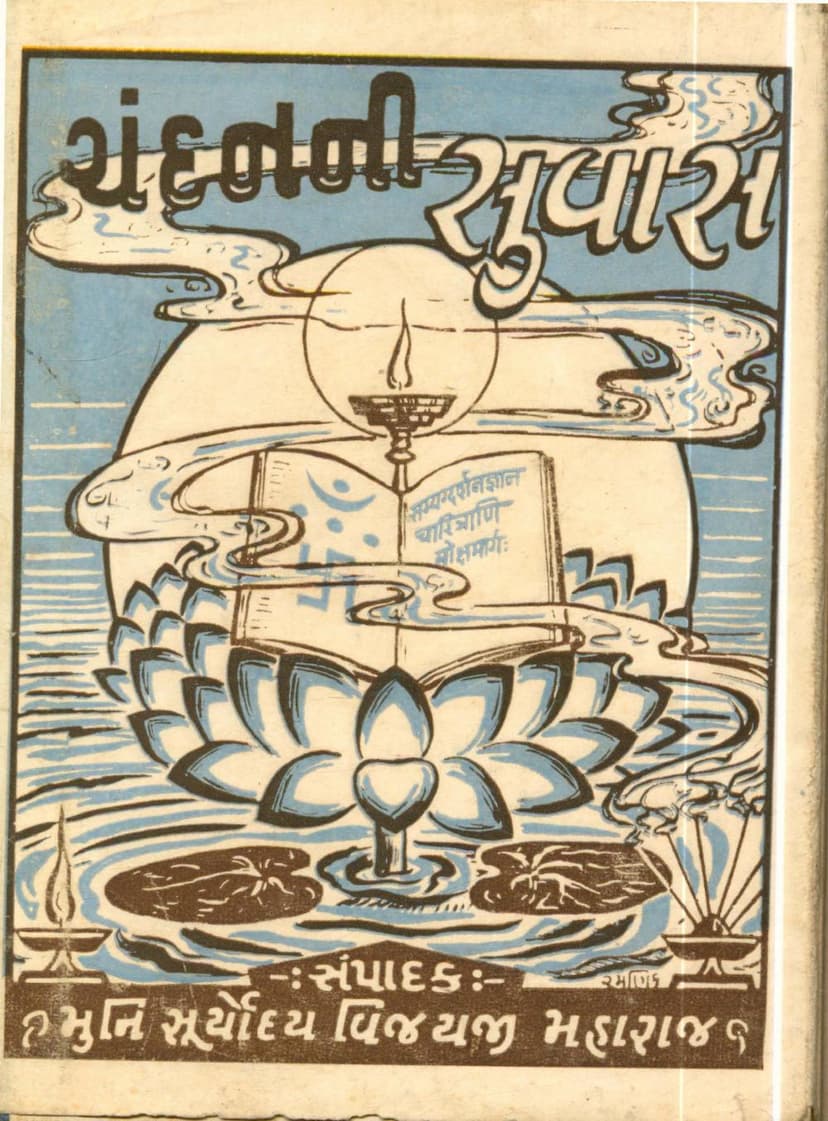Tattvarthadhigam Sutra
Added to library: September 2, 2025

Summary
This document is a Gujarati translation and commentary on the Tattvarthadhigama Sutra by Acharya Umaswati, with a commentary titled Bhadrakarodayakhya Bhashyarth Sahit. The work is edited by Muni Suryodayvijay Gani, published by Nemchand Nagji Doshi, and is the second edition.
The text provides a comprehensive overview of Jain philosophy and cosmology, structured into ten chapters (Adhyayas). Here's a breakdown of the content based on the provided pages:
Key Aspects of the Text:
- Author and Publisher: The book is the Tattvarthadhigama Sutra by Acharya Umaswati, with a commentary called "Bhadra Karodayakhya Bhashyarth" by Gyani Panyas Shri Shubhankar Vijay Gani. The editor is Muni Suryodayvijay Gani. The publisher is Nemchand Nagji Doshi, and it's available from Yashobhadra Shubhankar Gyan Shala in Godhra and Saraswati Pustak Bhandar in Ahmedabad.
- Purpose: The publication aims to provide a concise and accessible explanation of the Tattvarthadhigama Sutra, which is considered a fundamental text in Jainism. It is intended to help spiritual seekers (atmarthi) achieve peace.
- Commentary and Structure: The text includes the original sutras (verses) along with their Gujarati translation and commentary. The commentary delves into the meaning and implications of each sutra, drawing from established Jain principles.
- The Tattvarthadhigama Sutra: This foundational text expounds on the core principles of Jainism, covering metaphysics, ethics, cosmology, and the path to liberation.
Summary of Chapters (Adhyayas):
The document outlines the content of each of the ten chapters, which systematically cover the Jain worldview:
- Chapter 1 (Prathamo Adhyayah): Samyagdarshan, Jnan, Charitraani Mokshamargah (Right Faith, Right Knowledge, Right Conduct are the Path to Liberation): This chapter introduces the fundamental path to liberation, emphasizing the interconnectedness of right faith, knowledge, and conduct. It defines the tattvas (fundamental realities) and the nature of knowledge.
- Chapter 2 (Dwitiyo Adhyayah): Aupashamik-Kshayikau Bhavo Mishraścha Jivasya (The States of Subsidence, Annihilation, and Mixed, and the Soul): This chapter discusses the different modes (bhavas) of the soul, including subsidence, annihilation, mixed, causal (audayika), and eternal (parinamic). It details the classifications of souls, senses, bodies, and vital energies.
- Chapter 3 (Tritiyo Adhyayah): Description of the Universe: This chapter describes the structure of the Jain universe, including the different realms of existence, the seven netherworlds (Naraka), the continents and oceans, and Mount Meru. It also touches upon the lifespan and characteristics of beings in these realms.
- Chapter 4 (Chaturtho Adhyayah): Devas and Their Realms: This chapter focuses on celestial beings (Devas), classifying them into four categories: Bhavanvasi (dwellers of habitations), Vyantar (intermediate beings), Jyotishka (luminous beings), and Vaimanika (celestial beings residing in vehicles). It details their abodes, lifespans, and characteristics.
- Chapter 5 (Panchamo Adhyayah): Ajivakaya (Non-sentient Substances): This chapter explains the non-sentient substances in Jainism: Dharma (principle of motion), Adharma (principle of rest), Akash (space), and Pudgala (matter). It describes their properties, existence, and pervasiveness.
- Chapter 6 (Shashtho Adhyayah): Bandha Hetavah (Causes of Bondage): This chapter details the causes of karmic bondage, including the role of passions (kashayas), senses, activity (yoga), and other factors. It elaborates on the types of karma and their permutations.
- Chapter 7 (Saptamo Adhyayah): Virati Vratam (Abstinences and Vows): This chapter discusses the vows and abstinences that are essential for spiritual progress. It outlines the vows against violence, untruth, stealing, incontinence, and possession, and the subdivisions of these vows.
- Chapter 8 (Ashtamo Adhyayah): Bandha (Bondage) and its Details: This chapter delves deeper into the mechanics of karmic bondage, explaining the eight types of karma, their sub-categories, durations, and the factors that influence them. It also identifies what constitutes merit (punya) and demerit (papa).
- Chapter 9 (Navamo Adhyayah): Samvara and Nirjara (Cessation of Influx and Elimination of Karma): This chapter explains the principles of Samvara (stopping the influx of new karma) and Nirjara (shedding existing karma). It details the methods to achieve these, including guptis (restraint), samitis (careful actions), dharma (virtues), anupreksha (contemplations), parishaha jaya (conquest of hardships), and charitra (conduct). It also elaborates on penances (tapas).
- Chapter 10 (Dashamo Adhyayah): Moksha (Liberation): This chapter describes the state of liberation (Moksha), which is achieved through the complete annihilation of karma. It explains the nature of the liberated soul, its location in the Siddhashila, and the eternal bliss it experiences.
Additional Content:
- Bhadra Karodayakhya Bhashyarth: The commentary appears to be extensive and aims to elucidate the sutras thoroughly.
- Naya Karnika: A section on "Naya" (standpoints or perspectives) by Acharya Vinay Vijay is included, which is crucial for understanding the subtle nuances of Jain logic and philosophy. This part explains the seven Nayas (Naigama, Sangraha, Vyavahara, Rjusutra, Shabda, Samabhirudha, EvamBhuta) and their role in comprehending reality.
- Dedication: The book is dedicated to the spiritual preceptors of the editor.
- Acknowledgements: A list of donors who contributed to the publication is included.
- Sanskrit Verses: The text contains Sanskrit verses, particularly from the Tattvarthadhigama Sutra itself and the commentary.
Overall Significance:
The Tattvarthadhigama Sutra, as presented with this commentary, serves as a comprehensive guide to the Jain path to liberation. It systematically explains the Jain metaphysical principles, ethical guidelines, and the process of spiritual evolution, making it an invaluable resource for students and practitioners of Jainism. The inclusion of the "Naya Karnika" further highlights the intellectual depth and logical framework of Jain philosophy.